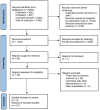The effects of various nutritional supplements in patients with chronic obstructive pulmonary disease: a network meta-analysis
- PMID: 40340688
- PMCID: PMC12060334
- DOI: 10.1186/s12890-025-03667-0
The effects of various nutritional supplements in patients with chronic obstructive pulmonary disease: a network meta-analysis
Abstract
Objective: To evaluate the effectiveness of various nutritional supplements as interventions for patients with Chronic Obstructive Pulmonary Disease (COPD) using network meta-analysis.
Methods: We searched PubMed, Embase, Cochrane Library, and Web of Science databases for randomized controlled trials on nutritional supplements for COPD patients, with the search updated to March 24, 2025. The risk of bias for each included study was assessed using appropriate tools, and the certainty of evidence was evaluated according to the Grading of Recommendations Assessment, Development, and Evaluation (GRADE) approach. Data synthesis was performed using R software, employing network meta-analysis methods to compare the relative efficacy of different nutritional interventions.
Results: Thirty-seven studies involving 1975 COPD patients and 21 different nutritional supplements were analyzed. Butyrate [MD = 2.7, 95% CrI (1.0, 4.4)], Nanocurcumin [MD = 13, 95% CrI (5.4, 21)], and probiotics [MD = 7.1, 95% CrI (5.2, 9.1)] significantly improved Forced Expiratory Volume in One Second (FEV1). Nanocurcumin also slowed the decline in the ratio of Forced Expiratory Volume in One Second to Forced Vital Capacity (FEV1/FVC) [MD = 12, 95% CrI (5.5, 18)]. For exercise endurance, coenzyme Q10 combined with creatine [MD = 63, 95% CrI (36, 90)], Melatonin (MLT) [MD = 46, 95% CrI (1.3, 92)], Nitrate [MD = 30, 95% CrI (19, 41)], and whey proteins [MD = 11, 95% CrI (9.2, 13)] significantly improved 6-minute walk distance (6MWD). Regarding dyspnea reduction, MLT [MD = -0.90, 95% CrI (-1.6, -0.21)] and Yam-Epimedium [MD = -1.3, 95% CrI (-1.9, -0.67)] significantly lowered modified Medical Research Council (mMRC) scores. In terms of quality of life, MLT [MD = -8, 95% CrI (-12, -4.2)], Vitamin D (VD) [MD = -2.5, 95% CrI (-3.1, -1.9)], and whey proteins [MD = -0.70, 95% CrI (-0.99, -0.41)] reduced COPD Assessment Test (CAT) scores. Additionally, AKL1 [MD = -9.2, 95% CrI (-18, -0.41)], creatine [MD = -9.6, 95% CrI (-17, -2.8)], and Yam-Epimedium [MD = -24, 95% CrI (-34, -13)] lowered St. George's Respiratory Questionnaire (SGRQ) scores. The Surface Under the Cumulative Ranking Curve (SUCRA) analysis showed Nanocurcumin ranked highest for improving FEV1/FVC, coenzyme Q10 combined with creatine for 6MWD, Yam-Epimedium for reducing dyspnea and SGRQ, and MLT for lowering CAT scores.
Conclusion: This analysis indicates that various nutritional supplements, including Nanocurcumin, butyrate, probiotics, coenzyme Q10 combined with creatine, MLT, nitrate, whey proteins, VD, AKL1, creatine, and Yam-Epimedium, can potentially benefit COPD patients, demonstrating differing levels of effectiveness. Specifically, Nanocurcumin may be the best choice for improving lung function; coenzyme Q10 combined with creatine may be the most effective for enhancing exercise endurance; Additionally, Yam-Epimedium is the most likely supplement to reduce the symptoms of dyspnea in COPD patients. Yam-Epimedium and MLT may be the most effective for improving quality of life and overall health status.
Keywords: Chronic obstructive pulmonary disease; Dietary supplement; Network meta-analysis.
© 2025. The Author(s).
Conflict of interest statement
Declarations. Ethics approval and consent to participate: Not applicable. Consent for publicatiosn: Not applicable. Competing interests: The authors declare no competing interests.
Figures






Similar articles
-
Comparative Efficacy of Nutritional Supplements in Modulating Lung Function and Exercise Capacity in COPD Patients: A Network Meta-Analysis.Int J Chron Obstruct Pulmon Dis. 2025 May 17;20:1525-1541. doi: 10.2147/COPD.S517252. eCollection 2025. Int J Chron Obstruct Pulmon Dis. 2025. PMID: 40401105 Free PMC article.
-
Optimal Exercise Modalities and Doses for Alleviating Dyspnea Symptoms and Enhancing Exercise Capacity in Patients With Chronic Obstructive Pulmonary Disease: A Network and Dose-Response Meta-analysis.Arch Phys Med Rehabil. 2025 May 7:S0003-9993(25)00701-4. doi: 10.1016/j.apmr.2025.05.001. Online ahead of print. Arch Phys Med Rehabil. 2025. PMID: 40345474 Review.
-
Exploration of quantitative-effectiveness association between acupuncture temporal parameters and stable chronic obstructive pulmonary disease: A systematic review and dose-response meta-analysis of randomized controlled trials.Complement Ther Med. 2024 Jun;82:103048. doi: 10.1016/j.ctim.2024.103048. Epub 2024 May 10. Complement Ther Med. 2024. PMID: 38734186
-
A systematic review and meta-analysis of Liuzijue in stable patients with chronic obstructive pulmonary disease.BMC Complement Med Ther. 2020 Oct 14;20(1):308. doi: 10.1186/s12906-020-03104-1. BMC Complement Med Ther. 2020. PMID: 33054800 Free PMC article.
-
A Network Meta-Analysis of Aerobic, Resistance, Endurance, and High-Intensity Interval Training to Prioritize Exercise for Stable COPD.Int J Chron Obstruct Pulmon Dis. 2024 Sep 16;19:2035-2050. doi: 10.2147/COPD.S476256. eCollection 2024. Int J Chron Obstruct Pulmon Dis. 2024. PMID: 39309599 Free PMC article.
References
-
- Patel N. An update on COPD prevention, diagnosis, and management: the 2024 GOLD report. Nurse Pract. 2024;49(6):29–36. 10.1097/01.NPR.0000000000000180. - PubMed
-
- Watanabe N, Fujita Y, Nakayama J, Mori Y, Kadota T, Hayashi Y, et al. Anomalous epithelial variations and ectopic inflammatory response in chronic obstructive pulmonary disease. Am J Respir Cell Mol Biol. 2022;67(6):708–19. 10.1165/rcmb.2021-0555OC. - PubMed
-
- Christenson SA, Smith BM, Bafadhel M, Putcha N. Chronic obstructive pulmonary disease. Lancet. 2022;399(10342):2227–42. 10.1016/S0140-6736(22)00470-6. - PubMed
Publication types
MeSH terms
LinkOut - more resources
Full Text Sources
Medical
Miscellaneous

